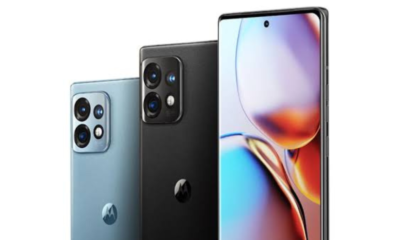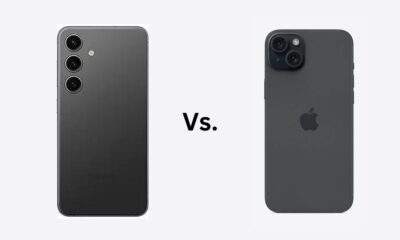Reviews
iPhone 15 Pro Max vs. Galaxy S23 Ultra

iPhone 15 Pro Max vs. Galaxy S23 Ultra: Design and Display
The iPhone 15 Pro Max adopts a design featuring glass and titanium, shedding nearly 20 grams from previous models, weighing in at 221 grams. In contrast, the Galaxy S23 Ultra boasts a glass and aluminum build, slightly heavier at 234 grams. Both phones offer IP68 dust and water resistance. The iPhone’s 6.7-inch display surpasses the Galaxy’s 6.8-inch screen in brightness, reaching up to 2,000 nits compared to the Galaxy’s 1,750 nits. The iPhone’s lighter design and brighter display make it the winner in this category.
Winner: iPhone 15 Pro Max
Performance, Battery Life, and Charging
The iPhone 15 Pro Max is powered by Apple’s A17 Pro chipset, built on the 3nm process, delivering impressive performance for gaming and daily tasks. The Galaxy S23 Ultra employs the Qualcomm Snapdragon 8 Gen 2 chipset, offering solid performance. While the iPhone excels in GPU performance, the Galaxy S23 Ultra prevails with longer battery life and faster 45W charging compared to the iPhone’s 27W. With a performance beast in the A17 Pro chip, but superior battery life and charging on the Samsung phone, the S23 Ultra emerges as the winner.
Winner: Samsung Galaxy S23 Ultra
iPhone 15 Pro Max vs. Galaxy S23 Ultra: Cameras
The Galaxy S23 Ultra boasts a highly versatile camera setup, including a 200MP primary camera and two 10MP telephoto sensors for 3x and 10x optical zoom. The iPhone 15 Pro Max introduces a 5x optical zoom but lacks the 3x optical zoom present in the iPhone 15 Pro. The iPhone’s 5x telephoto lens has a wider aperture, potentially producing better low-light photos. Both phones deliver exceptional photo quality, making this category a tie.
Winner: Tie
iPhone 15 Pro Max vs. Galaxy S23 Ultra: Software and Updates
Apple’s iOS offers a proven track record of consistent updates, with at least five years of major updates and extended security support. The iPhone 15 Pro Max ships with iOS 17, ensuring longevity. Samsung’s update policy promises four years of Android OS upgrades and five years of security patches. The choice between iOS and Android comes down to personal preference, resulting in a tie.
Winner: Tie
Special Features
Both phones offer unique features such as Dynamic Island and Live Activities on the iPhone 15 Pro Max and an integrated stylus for the Galaxy S23 Ultra. The Galaxy S23 Ultra’s special camera capabilities, including 100x zoom and moon shots, set it apart. Special features make it a tie.
Winner: Tie
Which One Should You Buy?
Choosing between the iPhone 15 Pro Max and Galaxy S23 Ultra depends on individual preferences. The iPhone excels in design, display, and unique features, while the Galaxy stands out in camera versatility, battery life, and charging speed. For Apple enthusiasts, the iPhone 15 Pro Max is a clear choice, while Android users may find the Galaxy S23 Ultra more appealing. Ultimately, both phones offer top-notch features, ensuring a satisfying smartphone experience.
Overall Winner: Tie
Frequently Asked Questions
Q1: What are the key differences between the iPhone 15 Pro Max and Galaxy S23 Ultra?
A1: The main differences include design and build materials, camera specifications, operating systems (iOS 17 for iPhone and Android 13 with One UI 5.1 for Galaxy), and unique features like Dynamic Island on the iPhone and the built-in stylus on the Galaxy S23 Ultra.
Q2: How do the camera systems compare between the two phones?
A2: The Galaxy S23 Ultra boasts a more versatile camera setup with a 200MP primary camera, while the iPhone 15 Pro Max introduces a 5x optical zoom. Both phones deliver exceptional photo quality, making the camera comparison subjective based on personal preferences.
Q3: What about performance and battery life?
A3: The iPhone 15 Pro Max is powered by the Apple A17 Pro chipset, while the Galaxy S23 Ultra houses the Snapdragon 8 Gen 2 for Galaxy. The Galaxy S23 Ultra wins in battery life and charging speed, featuring a 5,000mAh battery with 45W Super Fast Charging.
Q4: How do the display and design differ?
A4: The iPhone 15 Pro Max features a 6.7-inch OLED display with ProMotion (120Hz dynamic), while the Galaxy S23 Ultra has a slightly larger 6.8-inch Dynamic AMOLED 2X display. Design variations include different build materials, with the iPhone using glass and titanium and the Galaxy featuring a glass and aluminum build.
Q5: What is the pricing and availability of these phones?
A5: Both phones start at $1,199 and are available from all major offline and online retailers. The Galaxy S23 Ultra may be found at discounted prices over time.
Reviews
Xiaomi Redmi Note 13R Specifications

The Xiaomi Redmi Note 13R was officially announced on May 17, 2024, and has been available for purchase since the same day.
Design and Build
The Redmi Note 13R features a sleek design with dimensions of 168.6 x 76.3 x 8.2 mm and a weight of 205 grams. It boasts a glass front, a plastic frame, and a glass back, providing a premium feel while maintaining durability. The device supports dual Nano-SIM cards with dual standby and is rated IP53 for dust and splash resistance.
Display
Equipped with a 6.79-inch IPS LCD screen, the Redmi Note 13R offers a high refresh rate of 120Hz and a brightness of 550 nits. The display resolution is 1080 x 2460 pixels, resulting in a sharp density of approximately 396 ppi and an impressive screen-to-body ratio of around 85.1%.
Performance
Running on Android 14 with Xiaomi’s HyperOS overlay, the Redmi Note 13R is powered by the Qualcomm SM4450 Snapdragon 4+ Gen 2 chipset built on a 4 nm process. Its octa-core CPU consists of 2×2.3 GHz Cortex-A78 cores and 6×1.95 GHz Cortex-A55 cores, paired with an Adreno 613 GPU for smooth graphics performance.
Memory and Storage
The smartphone offers multiple memory configurations:
– 128GB storage with 6GB or 8GB RAM
– 256GB storage with 8GB or 12GB RAM
– 512GB storage with 12GB RAM
All variants use UFS 2.2 technology for faster data access and storage efficiency. Note that there is no memory card slot available for expandable storage.
Camera System
The dual-camera setup on the rear includes:
– A 50 MP main sensor with an f/1.8 aperture, PDAF, and a pixel size of 0.64µm
– A 2 MP macro sensor with an f/2.4 aperture
This setup is complemented by features such as LED flash and HDR, and can record videos at 1080p@30fps. The front camera houses an 8 MP wide sensor capable of the same video recording quality.
Audio
For audio enthusiasts, the Redmi Note 13R includes a loudspeaker, a 3.5mm headphone jack, and supports 24-bit/192kHz Hi-Res audio.
Connectivity
The device supports a range of connectivity options, including:
– Wi-Fi 802.11 a/b/g/n/ac (dual-band)
– Bluetooth 5.3 with A2DP and LE
– GPS, GLONASS, GALILEO, and BDS for positioning
– NFC for contactless payments
– An infrared port for remote control functions
The device features a USB Type-C port for charging and data transfer.
Additional Features
The Redmi Note 13R includes several sensors, such as a side-mounted fingerprint sensor, an accelerometer, and a compass, along with virtual proximity sensing for enhanced user interaction.
Battery and Charging
The phone is equipped with a non-removable 5030 mAh battery, supporting 33W wired charging, ensuring long-lasting usage and quick recharge times.
Colors and Pricing
The Xiaomi Redmi Note 13R is available in three colors: Black, Blue, and Silver. It is priced at approximately 180 EUR, making it a competitive option in its segment.
In summary, the Xiaomi Redmi Note 13R combines robust performance, a versatile camera system, and a high-refresh-rate display, all within a budget-friendly package.
Reviews
OPPO Reno 12 Series: Design, Launch Date and Specifications

OPPO has officially unveiled the front image rendering of its highly anticipated Reno 12 series of smartphones. This new series is set to introduce a fresh wave of innovation and design to the market. According to OPPO, the Reno 12 series incorporates a built-in anti-accidental touch algorithm designed to prevent unintended screen interactions. Additionally, the company has optimized the device’s ergonomics, ensuring it “feels good when held horizontally or vertically.” The official launch date for the Reno 12 series is set for May 23rd.
Design and Display
The Reno 12 series features a distinctive “four-curve soft-edge straight screen” design, akin to the “equal-depth slightly curved screen” concept. The screen curves gently on all four sides, giving it a straight-screen appearance from the front. This design not only enhances the phone’s aesthetic appeal but also improves grip comfort and usability. Available in two colors—silver and purple—the Reno 12 series exudes sophistication and elegance. The metallic purple variant, in particular, offers a smooth, gemstone-like feel under a glossy glass finish.
The Reno 12 Pro model boasts a 6.7-inch 1.5K 120Hz equal-depth quad-curved screen. This model is expected to feature a curved glass back and an IP65 rating for dust and water resistance. OPPO’s innovative system-level technology enhances the phone’s fluency and stability, promising a smooth user experience even after 48 months of use. The device’s 3D curved design ensures that both the screen and back cover fit comfortably in hand, providing an exceptional feel.
Performance and Cameras
The Reno 12 series includes the standard Reno 12, equipped with a MediaTek Dimensity 8250 processor, and the Reno 12 Pro, which features the more advanced Dimensity 9200 + Starspeed processor. These processors ensure fast performance, efficient battery life, and seamless multitasking capabilities.
The Reno 12 Pro’s camera setup includes a 50-megapixel JN5 front camera, a 50-megapixel IMX890 main camera, an 8-megapixel ultra-wide-angle lens, and a 50-megapixel JN5 2x telephoto lens. This quad-camera configuration is designed to capture high-quality images and videos, making it an attractive option for photography enthusiasts.
Battery and Charging
The Reno 12 series is powered by a large 5000mAh battery, providing all-day battery life. The series also supports 80W fast charging, allowing users to quickly recharge their devices. This feature is particularly beneficial for heavy users who need to keep their phones charged throughout the day.
Special Features
A standout feature of the Reno 12 series is its support for the Live Photo function on the Android platform. This feature addresses common issues with live photos on Android, offering a more seamless and enjoyable photography experience. The series also supports wireless Bluetooth calls, enabling users to make hands-free calls with ease.
The OPPO Reno 12 series marks a significant upgrade from its predecessors, offering a unique design, powerful performance, and advanced camera capabilities. The “four-curve soft-edge straight screen” design is likely to appeal to users who value both aesthetics and functionality. Additional features like the Live Photo function and wireless Bluetooth calls enhance the phone’s overall appeal, making it a compelling choice for those seeking a feature-rich smartphone. As the launch date approaches, tech enthusiasts and consumers are eagerly awaiting the opportunity to experience the Reno 12 series firsthand.
Reviews
Sony Xperia 1 VI Set for Unveiling With a Remarkable Camera

Sony’s latest flagship smartphone, the Sony Xperia 1 VI, has made its grand entrance, boasting a plethora of features tailored to cater to photographers and audiophiles alike. Released on May 15, 2024, the Xperia 1 VI promises to deliver an exceptional user experience, blending cutting-edge technology with Sony’s renowned craftsmanship.
Design and Display
Crafted with a sleek glass back adorned with a “textural rear panel finish” for enhanced grip, the Xperia 1 VI exudes elegance and functionality. Available in three sophisticated shades – Khaki Green, Platinum Silver, and Black – the device features a durable metal frame and a dedicated shutter key, catering to photography enthusiasts. Moreover, with dimensions of 162 x 74 x 8.2mm and weighing just 192g, the Xperia 1 VI strikes a perfect balance between portability and comfort.
Protected by Gorilla Glass Victus 2 on the front and Gorilla Glass Victus on the back, the device ensures robust durability and resistance to scratches. Its 6.5-inch OLED display, boasting a 19.5:9 aspect ratio, captivates users with vibrant visuals and immersive viewing experiences. Despite a downgrade in resolution to FHD+ (1080 x 2340), the Xperia 1 VI’s screen offers improved brightness and features AI-driven enhancements for optimal contrast, color, and clarity. Additionally, its variable refresh rate, ranging from 1Hz to 120Hz, guarantees seamless performance across various applications and activities.
Camera and Battery
The highlight of the Xperia 1 VI lies in its remarkable camera capabilities, particularly its 12MP telephoto lens, enabling users to zoom from 85mm to 170mm for unparalleled versatility. Complemented by a 48MP main sensor, a 12MP ultra-wide lens, and a 12MP front-facing camera, the device excels in capturing stunning photographs and videos in any setting. Equipped with AI-driven autofocus and image processing technologies, the Xperia 1 VI ensures superior image quality and precision, making every shot a masterpiece.
In terms of battery life, the Xperia 1 VI impresses with its 5,000mAh battery, delivering up to two days of usage under typical conditions and up to 36 hours of continuous video playback. Enhanced by Xperia Adaptive Charging technology, the device prolongs battery lifespan while supporting wireless charging and reverse wireless charging functionalities, ensuring uninterrupted usage throughout the day.
Specs and Features
Powered by a Snapdragon 8 Gen 3 chipset, coupled with 12GB of RAM and 256GB of storage, the Xperia 1 VI promises blazing-fast performance and ample storage for multitasking and multimedia consumption. Running on Android 14, the device guarantees seamless navigation and access to the latest features and updates.
Boasting a microSD card slot, a rarity among high-end handsets, the Xperia 1 VI offers expandable storage options for added convenience. Furthermore, with a commitment to three years of Android updates and four years of security patches, Sony ensures long-term reliability and security for its users.
Beyond its impressive hardware specifications, the Xperia 1 VI incorporates a host of software features tailored to enhance user experience. From an FPS optimizer for optimized gaming performance to advanced audio technologies such as High-Resolution Audio and LDAC support, the device caters to the diverse needs of modern consumers. Additionally, with its Music Pro feature leveraging AI to deliver studio-quality sound, the Xperia 1 VI redefines the audio experience on a smartphone.
In conclusion, the Sony Xperia 1 VI emerges as a powerhouse of innovation, combining cutting-edge technology with premium design aesthetics to deliver an unparalleled smartphone experience. With its focus on photography, audio excellence, and overall performance, the Xperia 1 VI stands poised to captivate users and elevate the standards of flagship smartphones in 2024 and beyond.
-

 Tech News7 days ago
Tech News7 days agoOnePlus 13 and 13R Potential Designs Unveiled
-

 Tech News4 days ago
Tech News4 days agoAndroid to Introduce Theft Detection Lock: Detecting When Your Phone is Snatched
-

 Tech News7 days ago
Tech News7 days agoSony Xperia 1 VI Camera Sensors Revealed
-

 Tech News7 days ago
Tech News7 days agoApple Nearing Deal with OpenAI to Integrate Generative AI Features into iOS 18
-

 Reviews4 days ago
Reviews4 days agoSony Xperia 1 VI Set for Unveiling With a Remarkable Camera
-

 Tech News6 days ago
Tech News6 days agoGoogle Pixel 9 Series to Introduce Four Distinct Models
-

 Reviews3 days ago
Reviews3 days agoXiaomi Redmi Note 13R Specifications
-

 Reviews3 days ago
Reviews3 days agoOPPO Reno 12 Series: Design, Launch Date and Specifications









